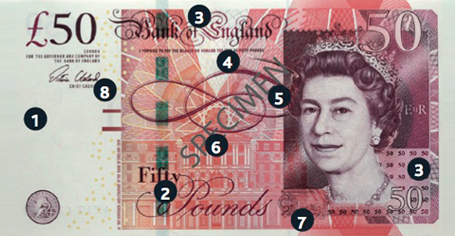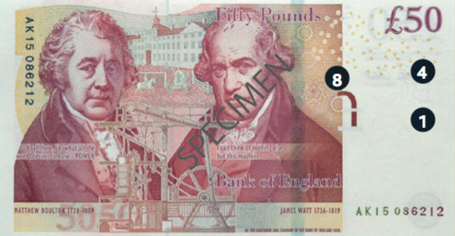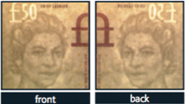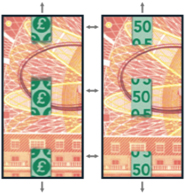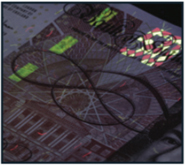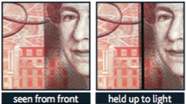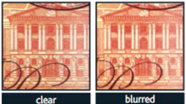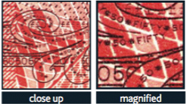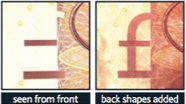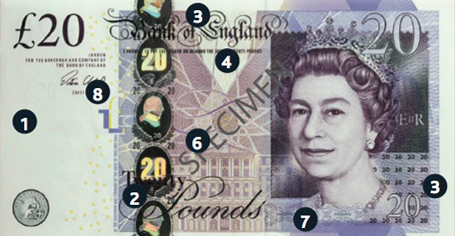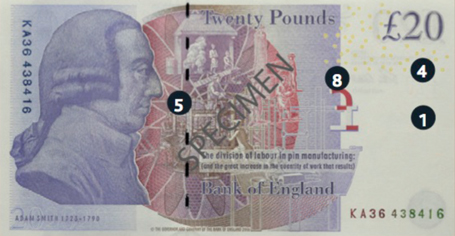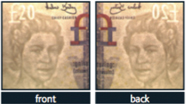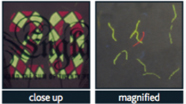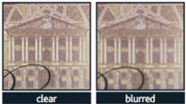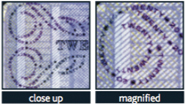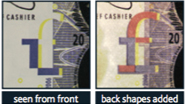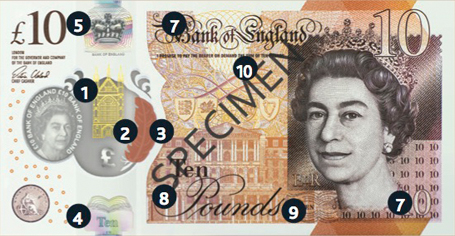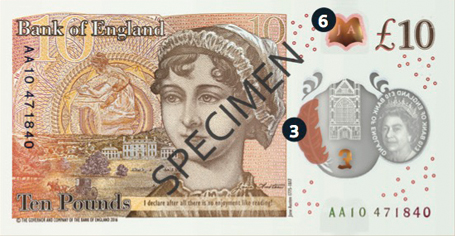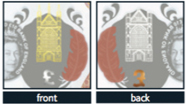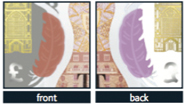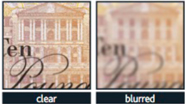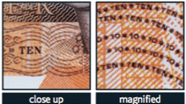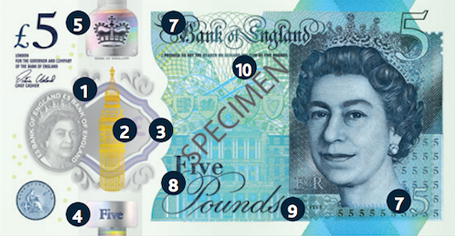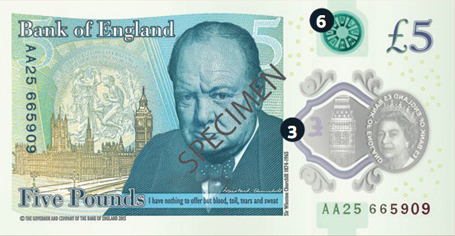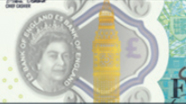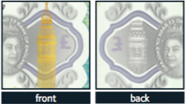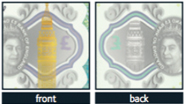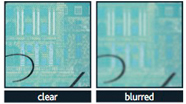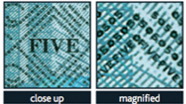British pound security features
There are currently four different denominations of Bank of England notes in circulation. Banknotes has 4 different banknotes in different values and sizes: £5, £10, £20 and £50. Pound sterling is the legal and official currency of the Great Britain.
Look at the note, and feel the note. Do not rely on one single feature. If you have doubts, compare the note with one that you know to be genuine. There are some counterfeit notes about. They are completely worthless. Don’t get caught out – protect yourself and check your banknotes when you receive them.
Security features help you to identify genuine banknotes. Take your time to check your notes, particularly if light conditions are poor or you are handling a large number of notes. Look for the Great Britain's pound sterling security features described below.
All GB pound banknotes: £5, £10, £20, £50 security features in detail
£50 GB pound banknote security features. Recognize your 50 GB pound banknote is not fake, spot a fake banknote
The £50 note, with the portraits of Matthew Boulton and James Watt on the back, is the highest denomination in value and largest in size (approx. 156mm x 85mm).
Motion Thread - the motion thread on the £50 note is woven into the paper. It has five windows along its length which contain images of the £ symbol and the number 50. When the note is tilted from side to side, the images move up and down. When the note is tilted up and down, the images move from side to side and the number 50 and £ symbol switch.
£50 GB pound Issued 2011 - Present
|
50 GB pound banknote. Front. 50 GB pound banknote. Back. Denomination numeral. Unique numbering. Copyright symbols. Historical characters. James Watt (1736-1819). Engineer and Scientist James Watt, born in Greenock, Scotland, was the great improver of the steam engine. His work reduced the steam wastage inherent in earlier designs and delivered considerable efficiencies. Watt also introduced the term 'horsepower' and the metric unit of power is named after him. In 1775 Boulton and Watt entered a partnership to develop and market steam engines. Initially these were for use in the mining and textile industries before they extended the innovation to benefit a wider range of industries in the UK and worldwide. Boulton and Watt were members of the Lunar Society, which helped to foster links between philosophy, arts, science and commerce. |
1) Check the watermark. Hold the note up to the light and you will see an image of the Queen’s portrait together with a ‘£50’ which is brighter than the surrounding paper. 2) Check the motion thread. The motion thread on the note is woven into the paper. It appears five times on the front of the note showing images of the £ symbol and the number 50. When the note is tilted from side to side, the images move up and down. When the note is tilted up and down, the images move from side to side and the number 50 and £ symbol switch. 3) Check the paper and the raised print. The note is printed on special paper that gives it its unique feel. By running your finger across the front of the note you can feel raised print in areas such as the words ‘Bank of England’ and in the bottom right corner, around the number 50. 4) Check the ultra-violet features. If you look at the front of the note under a good quality ultra-violet light the number 50 appears in bright red and green. The motion thread also appears bright green and randomly spread bright red and green flecks are visible on both the front and back of the note. The remainder of the note appears dull in contrast. 5) Check the metallic thread. There is a metallic thread embedded in every paper banknote. If you hold the note up to the light the metallic thread will appear as a continuous dark line. 6) Check the print quality. The printed lines and colours on the note are sharp, clear and free from smudges or blurred edges. 7) Check the microlettering. Using a magnifying glass, look closely at the lettering beneath the Queen’s portrait on the note – you will see the value of the note written in small letters and numbers. 8) Check the see-through register. Hold the note up to the light and you will see coloured irregular shapes printed on the front and back that combine to form the £ symbol. |
£20 GB pound banknote security features. Recognize your 20 GB pound banknote is not fake, spot a fake banknote
About GB pound exchange rate
GB pound is the third most popular currency in the world and always likes to show their independence from Europen Union or United States. Even Brexit shows that they want to b independent. GB pound rates changes every minute. It is important to know how strong GB pound is and what are GB pound exchange rates against other currencies. Most popular exchange rates people are following are: pound to us dollar, gb pound to euro, gb pound to yen, gb pound to ruble, gb pound to zloty, gb pound to rand, etc. Also, we provide versatile currency converter, which lets to calculate all different currencies among each other. We've prepared gbp converter, where you will calculate all the pairs from gb pound.
The £20 note, with a profile of Adam Smith on the back, is the second highest denomination note in value and the second largest in size (approx. 149mm x 80mm). The polymer £20 note will be issued in 2020. It will feature JMW Turner and will be 139mm x 73mm.
£20 GB pound Issued 2007 - Present
|
20 GB pound banknote. Front. 20 GB pound banknote. Back. Denomination numeral. Unique numbering. Copyright symbols. Historical character. |
1) Check the watermark. Hold the note up to the light and you will see an image of the Queen’s portrait together with a ‘£20’ which is brighter than the surrounding paper. 2) Check the holographic strip.. The strip on the note has a number of foil patches along its length which contain alternating holographic images. The positioning of the patches varies along the strip. When the note is tilted, one hologram shows a multi-coloured image of Adam Smith, the other flips between a multi-coloured £ symbol and the number 20. The number 20 is also embossed on the strip and is positioned in the same place on every note – just to the right of the signature of the Chief Cashier 3) Check the paper and the raised print. The note is printed on special paper that gives it its unique feel. By running your finger across the front of the note you can feel raised print in areas such as the words ‘Bank of England’ and in the bottom right corner, around the number 20. 4) Check the ultra-violet features. If you look at the front of the note under a good quality ultra-violet light the number 20 appears in bright red and green. Randomly spread bright red and green flecks are also visible on both the front and back of the note. The remainder of the note appears dull in contrast. 5) Check the metallic thread. There is a metallic thread embedded in every paper banknote. This appears as silver dashes on the back of the note. If you hold the note up to the light the metallic thread will appear as a continuous dark line. 6) Check the print quality. The printed lines and colours on the note are sharp, clear and free from smudges or blurred edges. 7) Check the microlettering. Using a magnifying glass, look closely at the lettering beneath the Queen’s portrait on the note – you will see the value of the note written in small letters and numbers. 8) Check the see-through register. Hold the note up to the light and you will see coloured irregular shapes printed on the front and back that combine to form the £ symbol. |
GBP exchange rates
£10 GB pound banknote security features. Recognize your 10 GB pound banknote is not fake, spot a fake banknote
On the front of the £10 polymer note (the side with raised print), there are two clusters of raised dots in the top left hand corner. This tactile feature helps blind and partially sighted people identify the value of the note. There are also a number of design elements which relate to Jane Austen. A portrait of Jane Austen can be found on the back of the note.
£10 GBP Note issued on 14 September 2017.
|
10 GB pound banknote. Front. 10 GB pound banknote. Back. £10 Design Tactile feature |
1) Check the see-through window. There is a large see-through window on the note. A clearly defined portrait of the Queen is printed on the window with the words ‘£10 Bank of England’ printed twice around the edge. 2) Winchester Cathedral.. A finely detailed metallic image of Winchester Cathedral is positioned over the window. The foil is gold on the front of the note and silver on the back. When the note is tilted a multi-coloured rainbow effect can be seen. The foil £ symbol in the window is silver on the front of the note and copper on the back. 3) Coloured quill. At the side of the window is a coloured quill which changes from purple to orange when the note is tilted. This effect can be seen on the front and back of the note. 4) Check the foil patches. On the front of the note, below the see-through window, is a silver foil patch. When the note is tilted the word ‘Ten’ changes to ‘Pounds’ and a multicoloured rainbow effect can be seen. 5) Foil crown. On the front of the note, above the see-through window, is a silver foil patch containing an image of the coronation crown which appears 3D. When the note is tilted a multi-coloured rainbow effect can be seen. 6) Copper foil patch. On the back of the note, there is a book-shaped copper foil patch which contains the letters JA. It is immediately behind the silver crown on the front. 7) Check the polymer and the raised print. The note is printed on polymer which is a thin and flexible plastic material. By running your finger across the front of the note you can feel raised print in areas such as the words ‘Bank of England’ and in the bottom right corner, around the number 10. 8) Check the print quality. The printed lines and colours on the note are sharp, clear and free from smudges or blurred edges. 9) Check the microlettering. Using a magnifying glass, look closely at the lettering beneath the Queen’s portrait – you will see the value of the note written in small letters and numbers. 10) Check the ultra-violet feature. If you look at the front of the note under a good quality ultra-violet light, the number 10 appears in bright red and green whilst the background remains dull in contrast. |
GBP exchange rates
£5 GB pound banknote security features. Recognize your 5 GB pound banknote is not fake, spot a fake banknote
The new fiver is printed on polymer - a thin and flexible plastic material. It’s around 15% smaller than the paper £5 note. The polymer £5 note, with the portrait of Sir Winston Churchill on the back, is the lowest denomination in value and smallest in size (approx. 125mm x 65mm).
Polymer £5 note was issued on 13 September 2016. Paper £5 notes valid until 5 May 2017.
|
5 GB pound banknote. Front. 5 GB pound banknote. Back. Denomination numeral. Unique numbering. Copyright symbols. Historical character. |
1) Check the see-through window.There is a large see-through window on the note. A clearly defined portrait of the Queen is printed on the window with the words ‘£5 Bank of England’ printed twice around the edge. 2) Elizabeth Tower.. A finely detailed metallic image of the Elizabeth Tower is positioned over the window. The foil is gold on the front of the note and silver on the back of the note. When the note is tilted a multicoloured rainbow effect can be seen. 3) Coloured border. Around the edge of the window is a coloured border which changes from purple to green when the note is tilted. The £ symbol in the window also changes from purple to green. This effect can be seen on the front and back of the note. 4) Check the foil patches. On the front of the note, below the see-through window, is a silver foil patch. When the note is tilted the word ‘Five’ changes to ‘Pounds’ and a multicoloured rainbow effect can be seen. 5) Foil crown. On the front of the note, above the see-through window, is a silver foil patch containing an image of the coronation crown which appears 3D. When the note is tilted a multi-coloured rainbow effect can be seen. 6) Green foil patch. On the back of the note, there is a circular green foil patch which contains the word BLENHEIM. It is immediately behind the silver crown on the front. 7) Check the polymer and the raised print. The note is printed on polymer which is a thin and flexible plastic material. By running your finger across the front of the note you can feel raised print in areas such as the words ‘Bank of England’ and in the bottom right corner, around the number 5. 8) Check the print quality. The printed lines and colours on the note are sharp, clear and free from smudges or blurred edges. 9) Check the microlettering. Using a magnifying glass, look closely at the lettering beneath the Queen’s portrait – you will see the value of the note written in small letters and numbers. 10) Check the ultra-violet feature. If you look at the front of the note under a good quality ultra-violet light, the number 5 appears in bright red and green whilst the background remains dull in contrast. |
